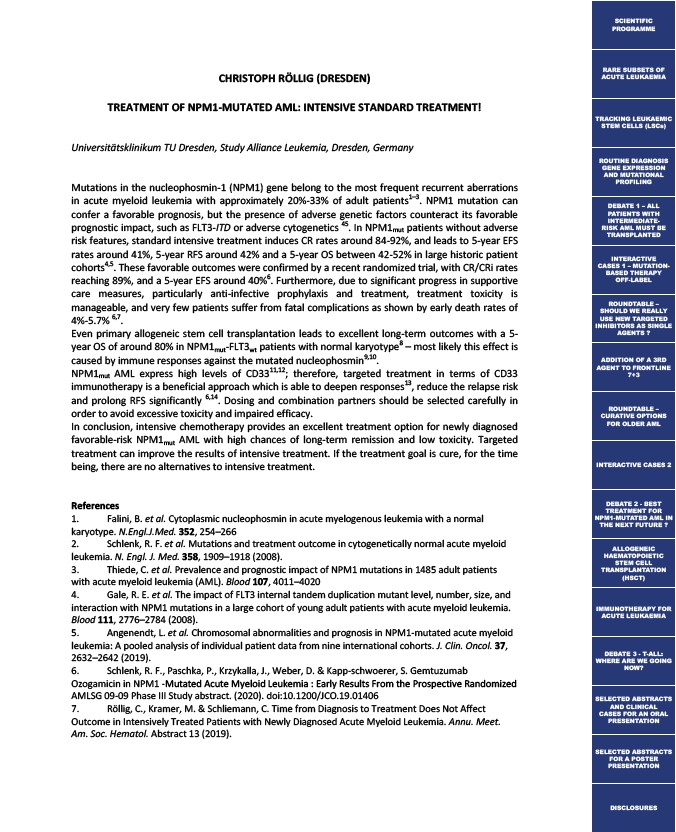
CHRISTOPH RÖLLIG (DRESDEN)
TREATMENT OF NPM1-MUTATED AML: INTENSIVE STANDARD TREATMENT!
Universitätsklinikum TU Dresden, Study Alliance Leukemia, Dresden, Germany
Mutations in the nucleophosmin-1 (NPM1) gene belong to the most frequent recurrent aberrations
in acute myeloid leukemia with approximately 20%-33% of adult patients1–3. NPM1 mutation can
confer a favorable prognosis, but the presence of adverse genetic factors counteract its favorable
prognostic impact, such as FLT3-ITD or adverse cytogenetics 45. In NPM1mut patients without adverse
risk features, standard intensive treatment induces CR rates around 84-92%, and leads to 5-year EFS
rates around 41%, 5-year RFS around 42% and a 5-year OS between 42-52% in large historic patient
cohorts4,5. These favorable outcomes were confirmed by a recent randomized trial, with CR/CRi rates
reaching 89%, and a 5-year EFS around 40%6. Furthermore, due to significant progress in supportive
care measures, particularly anti-infective prophylaxis and treatment, treatment toxicity is
manageable, and very few patients suffer from fatal complications as shown by early death rates of
4%-5.7% 6,7.
Even primary allogeneic stem cell transplantation leads to excellent long-term outcomes with a 5-
year OS of around 80% in NPM1mut-FLT3wt patients with normal karyotype8 – most likely this effect is
caused by immune responses against the mutated nucleophosmin9,10.
NPM1mut AML express high levels of CD3311,12; therefore, targeted treatment in terms of CD33
immunotherapy is a beneficial approach which is able to deepen responses13, reduce the relapse risk
and prolong RFS significantly 6,14. Dosing and combination partners should be selected carefully in
order to avoid excessive toxicity and impaired efficacy.
In conclusion, intensive chemotherapy provides an excellent treatment option for newly diagnosed
favorable-risk NPM1mut AML with high chances of long-term remission and low toxicity. Targeted
treatment can improve the results of intensive treatment. If the treatment goal is cure, for the time
being, there are no alternatives to intensive treatment.
References
1. Falini, B. et al. Cytoplasmic nucleophosmin in acute myelogenous leukemia with a normal
karyotype. N.Engl.J.Med. 352, 254–266
2. Schlenk, R. F. et al. Mutations and treatment outcome in cytogenetically normal acute myeloid
leukemia. N. Engl. J. Med. 358, 1909–1918 (2008).
3. Thiede, C. et al. Prevalence and prognostic impact of NPM1 mutations in 1485 adult patients
with acute myeloid leukemia (AML). Blood 107, 4011–4020
4. Gale, R. E. et al. The impact of FLT3 internal tandem duplication mutant level, number, size, and
interaction with NPM1 mutations in a large cohort of young adult patients with acute myeloid leukemia.
Blood 111, 2776–2784 (2008).
5. Angenendt, L. et al. Chromosomal abnormalities and prognosis in NPM1-mutated acute myeloid
leukemia: A pooled analysis of individual patient data from nine international cohorts. J. Clin. Oncol. 37,
2632–2642 (2019).
6. Schlenk, R. F., Paschka, P., Krzykalla, J., Weber, D. & Kapp-schwoerer, S. Gemtuzumab
Ozogamicin in NPM1 -Mutated Acute Myeloid Leukemia : Early Results From the Prospective Randomized
AMLSG 09-09 Phase III Study abstract. (2020). doi:10.1200/JCO.19.01406
7. Röllig, C., Kramer, M. & Schliemann, C. Time from Diagnosis to Treatment Does Not Affect
Outcome in Intensively Treated Patients with Newly Diagnosed Acute Myeloid Leukemia. Annu. Meet.
Am. Soc. Hematol. Abstract 13 (2019).
SCIENTIFIC
PROGRAMME
RARE SUBSETS OF
ACUTE LEUKAEMIA
TRACKING LEUKAEMIC
STEM CELLS (LSCs)
ROUTINE DIAGNOSIS
GENE EXPRESSION
AND MUTATIONAL
PROFILING
DEBATE 1 – ALL
PATIENTS WITH
INTERMEDIATE-RISK
AML MUST BE
TRANSPLANTED
INTERACTIVE
CASES 1 – MUTATION-BASED
THERAPY
OFF-LABEL
ROUNDTABLE –
SHOULD WE REALLY
USE NEW TARGETED
INHIBITORS AS SINGLE
AGENTS ?
ADDITION OF A 3RD
AGENT TO FRONTLINE
7+3
ROUNDTABLE –
CURATIVE OPTIONS
FOR OLDER AML
INTERACTIVE CASES 2
DEBATE 2 - BEST
TREATMENT FOR
NPM1-MUTATED AML IN
THE NEXT FUTURE ?
ALLOGENEIC
HAEMATOPOIETIC
STEM CELL
TRANSPLANTATION
(HSCT)
IMMUNOTHERAPY FOR
ACUTE LEUKAEMIA
DEBATE 3 - T-ALL:
WHERE ARE WE GOING
NOW?
SELECTED ABSTRACTS
AND CLINICAL
CASES FOR AN ORAL
PRESENTATION
SELECTED ABSTRACTS
FOR A POSTER
PRESENTATION
DISCLOSURES